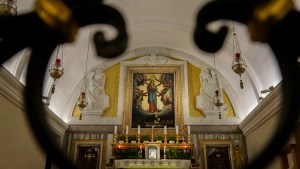The Maltese Archipelago is renowned for its picturesque coastline, exceptional diving spots, and vibrant festas. It also holds a deep and ancient devotion to the Virgin Mary, manifested in several Marian shrines popularly and officially recognized as being miraculous. The rich history and significance of these shrines, and the numerous Marian miraculous events and icons found in this small island nation ceaselessly draw pilgrims and devotees from around the world.
The role of Mary in Christianity
Myriam of Nazareth holds a central place in Christian theology as the Theotokos – literally, the God-bearer. Since the very early days of Christianity, Mary has been venerated for her virtue, obedience, and intercessory power. Indeed, the first Marian apparition (a bilocation, in fact) is traditionally believed to have occurred to the Apostle James in Spain around the year 40, while Mary was still alive. Tradition claims that when the apostle St. James the Greater was facing immense challenges while preaching in the Iberian Peninsula, he went to look for some solace in prayer by the banks of the Ebro river. During his supplications, the Virgin Mary appeared to him, standing on a jasper pillar carried by angels. This extraordinary event marked the first recorded apparition of the Blessed Mother – an event commemorated as Our Lady of the Pillar.
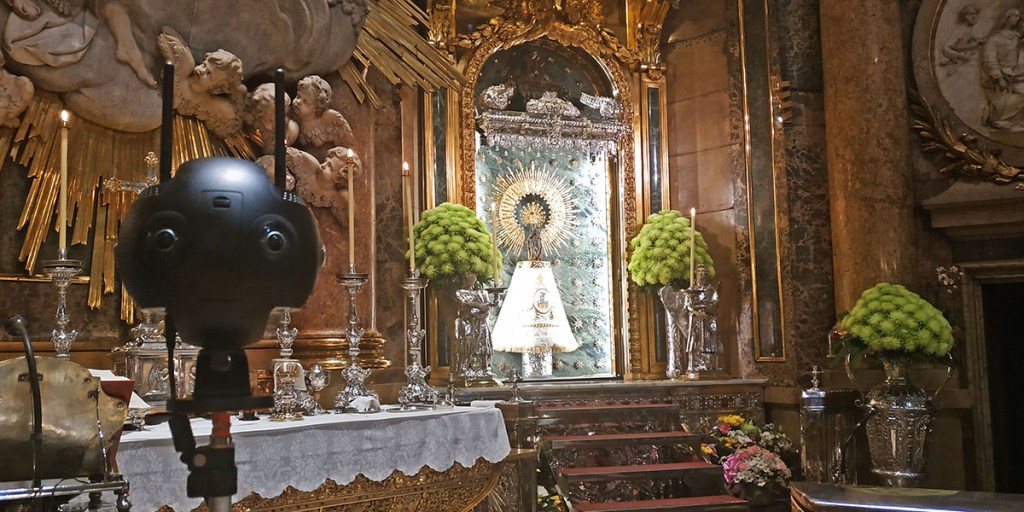
Since then, different traditions understand Mary’s intercessory role as a fundamental principle of Christian life. Numerous apparitions and miraculous events reported worldwide, including those of Fatima, Lourdes, and Guadalupe (just to name three of the most famous ones) have reinforced, spread, and confirmed this belief.
Malta, with its deep Marian devotion, has its own share of miraculous sites that underscore the island’s rich Christian heritage.
Malta’s Marian devotion
Malta’s Christian community dates back to the apostolic age, with the providential arrival of St. Paul in AD 60. This early establishment has resulted in an enduring and fervent Marian devotion among the Maltese people.
Malta boasts a remarkable number of churches and chapels, many of which are dedicated to the Virgin Mary. Among these, several stand out for the miraculous graces attributed to them. One of these significant Marian sites is the Sanctuary of Our Lady of Mellieħa. Local tradition holds that St. Luke the Evangelist himself, Paul’s companion during his trips, painted an image of the Virgin Mary during their stay on the island. However, further research has shown that the image dates back to the 13th century, possibly the 12th century.
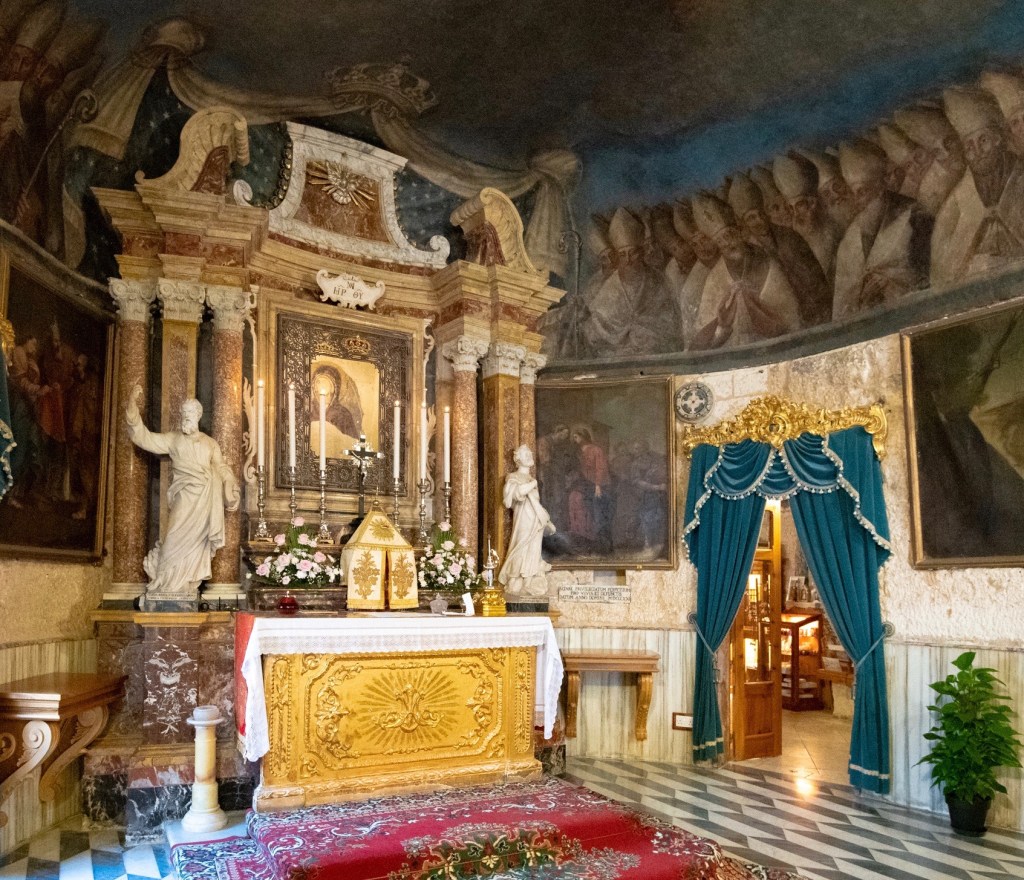
The icon, reflecting Byzantine traditions, depicts Mary in all her majesty, holding the Child Jesus and symbolizing her role as the Theotokos. Restoration work has revealed fascinating details about the icon, including inscriptions and symbols emphasizing Mary’s eternal virginity and royal status. This site has thus been a focal point for Marian devotion for centuries, with numerous pilgrims visiting to seek graces and offer thanks for miracles received. The sanctuary’s walls are covered with ex-votos, which range from handwritten notes to baby clothes (and even a motorcycle helmet!), all testifying to the Virgin’s intercessory power.
The underground grotto at the Sanctuary of Our Lady of Mellieħa is associated with multiple miraculous occurrences. The chapel in the grotto was hewn out of the hard limestone, thanks to a Sicilian devotee of Our Lady who was a regular visitor to the Sanctuary. He is also responsible for commissioning a white statue of Our Lady holding the Holy Infant on her left arm, at the far end of the chapel. Over the years, thousands of pilgrims have visited the underground chapel, and prayed before the Madonna, attributing to her many miraculous interventions and healings, both spiritual and temporal.

Events recorded in 1887, 1888, and 1948 are particularly famous. Various groups of people on different dates and time were gathered to pray and beheld the white statue of Our Lady repeatedly moving her right hand, making the Sign of the Cross. In the Sanctuary Archives there are 13 separate documents that record these happenings. All give a very detailed description of each event, and are signed under oath by all those present. The last time such a happening took place was reported after World War II, in 1948. A group of 10 people declared under oath that they witnessed the White Lady of the Chapel moving her right hand.
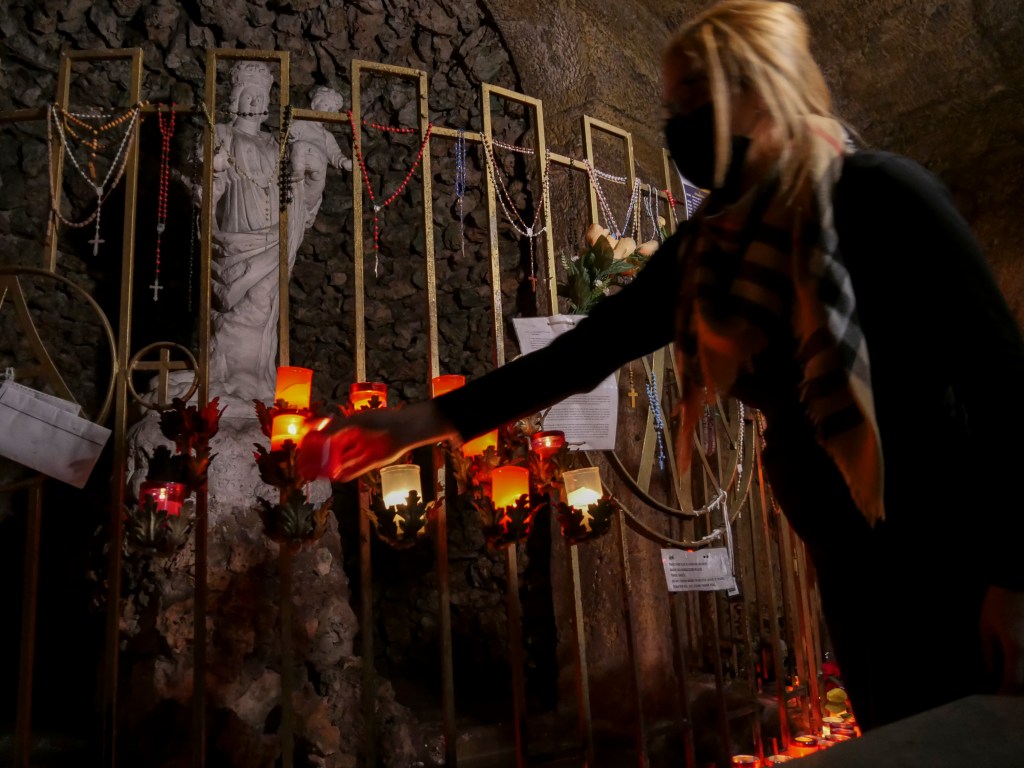
The icon of Our Lady of Mellieħa, and the white statue of Our Lady in the underground grotto are not alone. The Maltese archipelago is home to several miraculous images of the Virgin Mary. These images, revered by thousands of believers, are central to the island’s religious and cultural life.
Take, for example, the miraculous image kept at the Ta’ Pinu Basilica on the island of Gozo.
The beginnings of the devotion to the Blessed Virgin Mary of Ta’ Pinu are rather ancient. It is known that the original local church was a small chapel, known as Ta’ Ġentile, dedicated to the Assumption. The name Ta’ Ġentile was eventually dropped and the church became known as Ta’ Pinu (“Of Pinu,” Philip), named after Pinu Gauci, who had become the procurator of the church in 1598. Eventually, the modest unknown chapel in the countryside became a revered Marian shrine, visited by droves of Gozitans, Maltese and people beyond the sea. But why?
In 1883, Karmni Grima, from Għarb, heard a call on her way home. A mysterious voice called her three times: “Come! Come! Come!” Karmni was astounded, because at that time of the day, the fields were deserted, and no one could have possibly spoken to her. When she resumed her way, the same mysterious voice again told her: “Come, come, today, because a year will have passed before you will be able to visit this place again.” So, she walked toward the chapel, figuring that she would see the Blessed Virgin. She peeped through the little aperture in the door pane but saw no one.
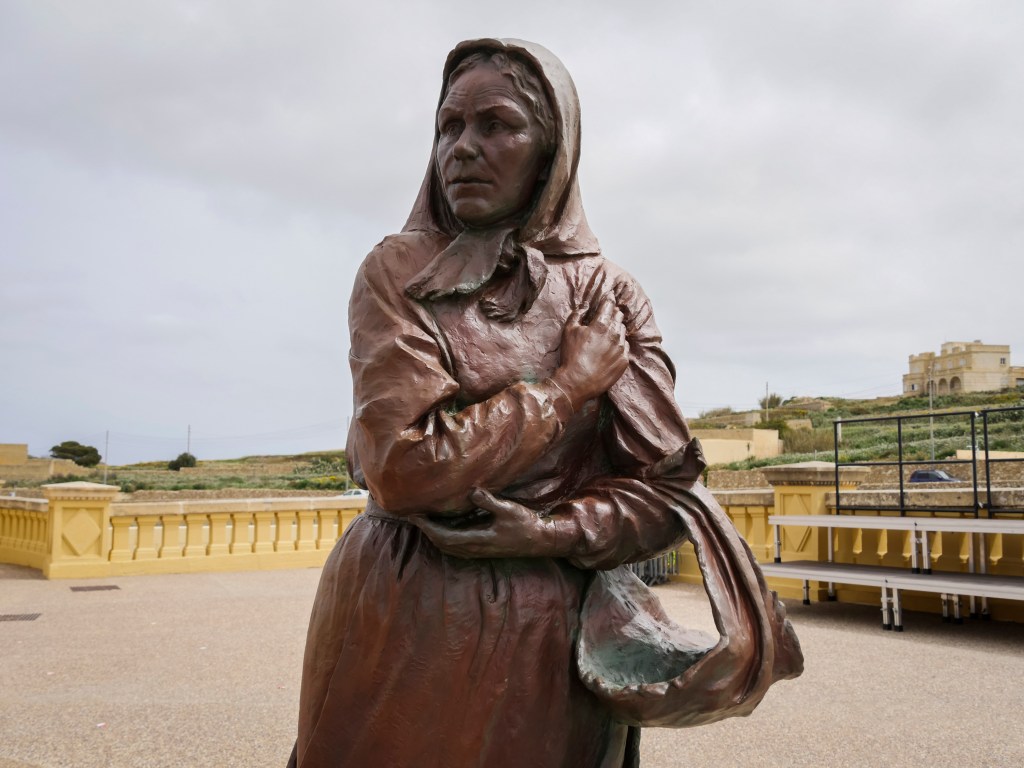
But when she entered the chapel to pray, a feeling of rapture gripped her. The same voice addressed her again: “Recite three Hail Marys in remembrance of the three days during which my body lay in the tomb” – and so she did. For two years, Karmni didn’t say word about what had happened. Then she disclosed her secret to Franġisk Portelli, an upright man who was renowned for his devotion to Our Lady of Ta’ Pinu. Amazingly, at about the same time, he had heard a mysterious voice asking him to say prayers in honor of Christ’s hidden shoulder wound caused by the weight of the heavy cross along the torturous path to Calvary. A short time later, Franġisk’s mother was miraculously healed by the intercession of the Blessed Virgin of Ta’ Pinu.
It was obvious that the matter could no longer be kept secret, and rumors that Our Lady of Ta’ Pinu had given a message to two persons from the village of Gharb began to spread like wildfire. Extant documents written by Karmni’s spiritual director also testify that the Blessed Virgin appeared to her even at her home in the village of Għarb. Today, Karmni’s home is open to visitors.
Ta’ Pinu Marian Shrine is also known as “The Church of Miracles.” Ex-votos literally cover the walls of two rooms on either side of the altar at Ta’ Pinu. These relate to cancers cured, babies born after years of infertility, horrific accidents resulting in completely healed patients, and many, many more amazing happenings and graces.
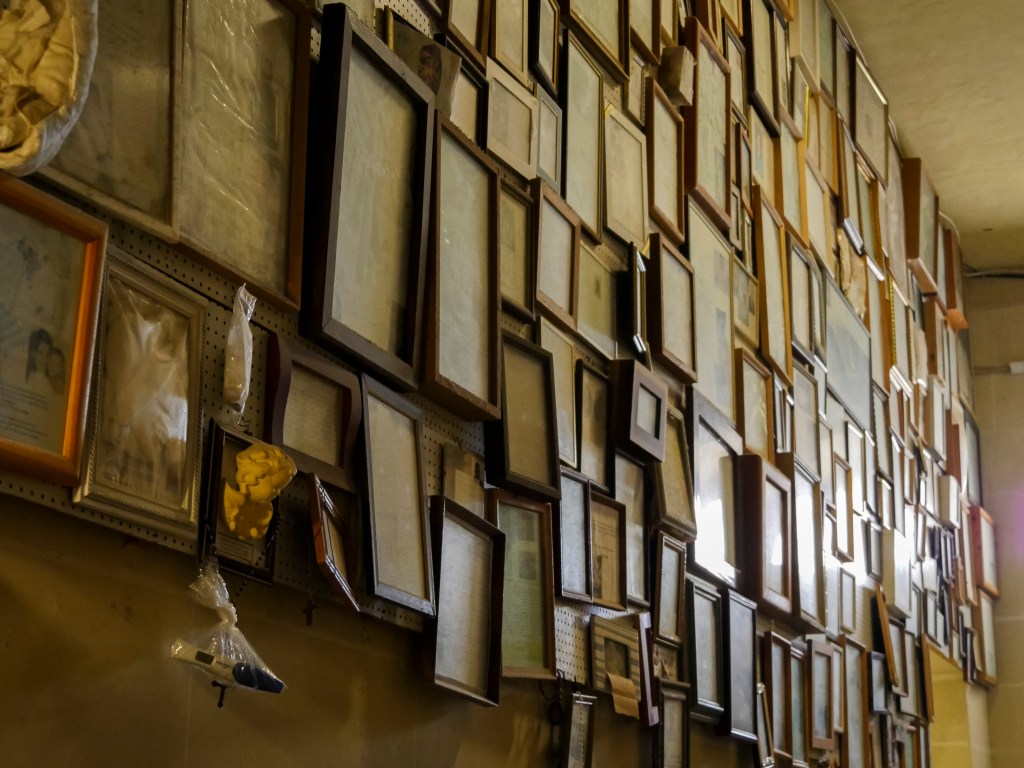
The journey of the icons
This Mediterranean island nation’s profound connection to the Blessed Virgin Mary is clearly visible in its numerous churches and miraculous icons. Among these, the 12th-century icon (c. 1150) of “Our Lady of Damascus” (Damaskinì) and the 13th / 14th-century icon (c. 1280 – 1330) of “Our Lady of Mercy” (Eleimonitria) stand out, having been brought to Malta by Christian refugees fleeing Islamic invasions on the Greek island of Rhodes.
The icons, saved from Islamic invasions and safely sheltered in Malta, display typical Syrian colors of gold and dark purple, and depict the Blessed Virgin Mary holding the Christ Child looking directly at the viewer. The Eleimonitria seems to always to have been in Rhodes in its own church before arriving in Malta. The Damaskini, a more ancient icon, was originally venerated in Damascus (Syria), whence it took its name. It was said to have reached Rhodes under miraculous circumstances in 1475. The Knights of St. John held the two icons of the Mother of God in great veneration, as did the local Maltese population.

The Great Siege and the role of Our Lady of Damascus
Grand Master Jean Parisot de la Valette, a fervent devotee, regularly prayed before the Damaskinì, especially during the Great Siege of 1565. Despite overwhelming odds, the Knights of Saint John and the Maltese defeated the Ottoman armada – a victory attributed to the intercession of the Blessed Virgin: the Ottoman superpower was defeated by the smallest of all Christian principalities! The grateful Grand Master presented his hat and sword as a votive offering, which are still displayed in the Museum of the Birgu (Vittoriosa) ancient parish church.
Immediately after the victory of 1565, the Maltese and the Knights added another title to their Heavenly Mother and began to call her “Our Lady of Victory” (Il-Madonna tal-Vitorja). In 1566, La Vallette laid the foundation stone of his new city, which later was given his name to honor him –Valletta. He ordered that the first building in his city was to be a church, which was erected on the foundation stone of the Fortress City.

The church was dedicated to the Nativity of the Blessed Virgin and Our Lady of Victory. On this occasion, the city of Senglea took the title of Citta Invicta – the “Undefeated City”. The citizens of Senglea also erected a church in honor of the Virgin’s Birth and Our Lady of Victory, which is today’s parish basilica and Marian sanctuary. The titular statue, dating to 1618, of Our Lady of Victory of the Senglea Basilica is truly a unique sculpture. Owing to its small size, it became widely known as Maria Bambina –“Child Mary.”
Maria Bambina: The miraculous statue of Senglea
The titular statue of Our Lady of Victory in Senglea Basilica, the Maria Bambina, also has a miraculous story to tell. It was discovered floating among the remains of a shipwrecked galleon and subsequently retrieved by the captain of an Austrian galley. As it was a religious image, he decided to donate it to a church on the first Christian land he sailed to. Malta was the captain’s next destination, and the statue was donated to the Senglea parish Church, following a request of two of his passengers, who happened to be Sengleans. Coincidence? Not likely! Even more so, at that time, the parish lacked both a statue and a painting of the Virgin Mary.

The statue has since then been the focus of numerous miraculous events, including the breaking of a long drought in 1718 following a penitential pilgrimage and the sparing of Senglea from a deadly plague in 1813. Remarkably, during World War II, on the feast of her Nativity and Victories, Italy surrendered to the Allies, a moment celebrated during the procession with the titular statue.
The Madonna tal-Marżabba: A tale of divine intervention
The parish church of Bormla, dedicated to the Immaculate Conception, houses a statue of Our Lady of the Immaculate Conception carved by Suor Maria de Domenici – a Carmelite tertiary and a pupil of the great Mattia Preti.
Tradition holds that when Malta formed part of the Royal Domain of the Kingdom of Aragon, a Sicilian merchant sloop was anchored in the Cospicua Creek. During a dark night, a sailor heard the loud shrieks and cries of a child. He reported this to the captain, and the captain himself with two other sailors landed and walked towards the cries. There, they had the fright of their lives when they saw a devil beating a hapless girl savagely. Frightened to death, they fell on their knees and prayed the Blessed Virgin to help the little girl. They immediately saw Our Heavenly Mother on a tree, with a branch (Marżabba, in Maltese – hence the title Madonna tal-Marżabba) in her hand, with which she beat the devil away.
As the captain approached the sobbing girl, he realized she was his daughter. Returning to his home, the captain found his wife in a desperate situation because she had cursed her daughter and asked the devil to take her away. A church dedicated to the Madonna tal-Marżabba was built near this tree as thanksgiving. This church no longer exists but in the same location we find the choir of the Collegiate Parish Church of the Immaculate Conception of Cospicua. The titular statue of the Immaculate Conception is said to have been carved out of the trunk of the tree on which Our Lady appeared.

Two chapels, two miraculous stories
The stories of two chapels, built as votive offerings for graces granted by the Blessed Virgin to two young women, are both under the mantle of the Assumption. These chapels stand as testaments to the enduring faith and devotion of the Maltese people, as it is deeply embedded in the history, culture, and architecture of the nation
The first of these chapels is a charming little church dedicated to the Assumption of Our Lady, found at the limits of Għargħur. This church is commonly referred to as taż-Żellieqa – which translates to “slippery” in Maltese. This name was bestowed upon it due to the poor condition of the road leading to it during the construction of the church in the 16th century.

According to tradition, this church was erected on the site where the Blessed Virgin Mary appeared to a young village woman in 1560 and cured her of a severe disease. In gratitude for her miraculous healing, the young woman built this church and dedicated it to the Assumption of the Blessed Virgin into Heaven. This event was documented by Msgr. Pietro Dusina in the report of his pastoral visit to Għargħur in 1575. During his visit, Dusina, the Pope’s representative, noted that the woman who had experienced the apparition was still alive. However, he did not record her name, or the exact date of the apparition.
The church standing today is not the original structure; over the years, devotion to the Madonna and this church continued to grow, prompting the construction of a larger structure as early as in 1650. The church underwent further significant enhancements in 1950, coinciding with the proclamation of the Dogma of the Assumption of Mary into Heaven. Following the approval of Metropolitan Archbishop Mgr. Michael Gonzi, two marble tablets were affixed to the facade of the church, one in Latin and the other in Maltese. These tablets commemorate Dusina’s words, reflecting on the miraculous event that led to the church’s foundation and the enduring devotion of the Maltese people to this sanctuary.
The people of Għargħur and its surrounding areas continue to preserve this church with deep love and great devotion. Many individuals make pledges, and several others present their infants in the church with particular affection to Our Lady, Mother of Jesus.
The second chapel, dedicated to Our Lady of Good Hope, is situated in a valley that takes its name from the church – the Valley of Good Hope, located in the limits of Mosta. According to tradition, around 1750, a peasant family working in fields near the village observed a party of corsairs approaching. During those times, pirate assaults were commonplace, with corsairs stealing whatever they found and capturing people to sell into slavery. The terrified farmers fled towards Mosta for safety.

While most of the family reached the village, a young woman in her early twenties, who was lame, could not keep up with her siblings. With the corsairs close behind her, she sought refuge in a cave and prayed fervently to Our Lady for protection, promising to build a church on the site if she was saved. In a remarkable turn of events, a spider built a web across the cave entrance, leading the pirates to believe that no one could have entered without disturbing it. Upon abandoning their search and leaving, the young woman emerged safely and, as she had promised, built a church on the site of her deliverance. This church, erected around 1757, stands as a testament to her faith and gratitude.
Pilgrims and individuals afflicted with illness have sought healing at this Marian sanctuary, and the sacristy and cave house contain numerous ex votos – evidence of gratitude on the part of those who have received graces. The story of the young woman’s miraculous escape and the subsequent church construction is remembered and revered to this day, serving as a powerful symbol of faith and divine protection.
Our Lady of the Grotto in Rabat
The devotion to Our Lady of the Grotto in Rabat has deep roots in the archipelago, beginning around 1400 when the Blessed Virgin appeared to a hunter, in a cave. This event sparked a significant following, with many people visiting the grotto to pray to Mary. The arrival of three Dominican friars from Sicily, who established a convent on the site, further amplified this devotion. As the number of devotees increased, the original crypt became inadequate, prompting the construction of a much larger church and priory, named for the Madonna of the Grotto.
The site became renowned for numerous miracles, including an oil lamp in front of the Madonna’s image that remained lit for four days despite the church being closed. There are plenty of accounts of miraculous healings, including a paralytic boy cured by the lamp’s oil and a man from Cospicua who was saved from a fatal accident after invoking the Madonna. The grotto became a sanctuary for those seeking divine intervention, particularly during the cholera outbreak in 1887 and the smallpox epidemic in 1899, with many reporting miraculous recoveries.

A noteworthy, recent occurrence took place on May 6, 1999, when a woman observed a reddish tear on the Virgin’s statue within the Priory. This phenomenon, initially concealed by the Sexton-General, reappeared the following day. Archbishop Joseph Mercieca promptly initiated an inquiry under the Vatican’s Dicastery for the Doctrine of the Faith. Forensic studies were conducted, and on December 12, 2003, the Archbishop’s Curia issued a press release encouraging the faithful to continue their devotion to Our Lady of the Grotto in a manner that is both worthy and authentic.
Our Lady of Miracles
In the village of Lija, an ancient Marian shrine known as the Church of Our Lady of Miracles, or Il-Madonna Tal-Mirakli, stands as a testament to the enduring, unwavering faith of the Maltese. The present church, built in 1664, replaced an older chapel located about 100 meters away. The original chapel housed a triptych painting by the 13th-century Sicilian artist Corso di Buono, depicting the Madonna with the Infant Jesus as the Savior of the World. Though not the titular altarpiece, this painting has been a focal point of devotion.
The chapel, originally dedicated to Our Lady of August, was later embellished by Grand Master Nicola Cotoner, who commissioned artist Mattia Preti to create a new altarpiece. Preti’s painting, which incorporated the Archangel Raphael in memory of Cotoner’s deceased brother, became the centerpiece of the new church. However, the old triptych painting is still housed in the church.

In 1743, a miraculous event heightened the devotion to this site. While lighting a lamp before the Holy Image (old triptych), the sexton noticed large water-like drops on the Madonna’s face, which were later confirmed to be human sweat. This phenomenon occurred just before a devastating earthquake hit Malta, causing no casualties, which many attributed to the Madonna’s protection.
This event led to a surge in pilgrims – and the construction of a sacristy to accommodate the influx of ex votos! Bishop Alpheran de Bussan, during his 1747 pastoral visit, noted the prodigious veneration and devotion at the church. The church was designated a significant devotional site on December 23, 1787, and in 1788, Pope Pius VI granted plenary indulgences on the feast days of the Assumption and the Immaculate Conception.

All these stories, spanning centuries and involving miraculous events and divine interventions, underscore the profound and enduring devotion to the Blessed Virgin Mary in Malta. Each chapel and church, constructed in gratitude and faith, stands as a unique testimony to the archipelago’s profound and enduring spiritual heritage.
This content has been brought to you in partnership with VisitMalta

